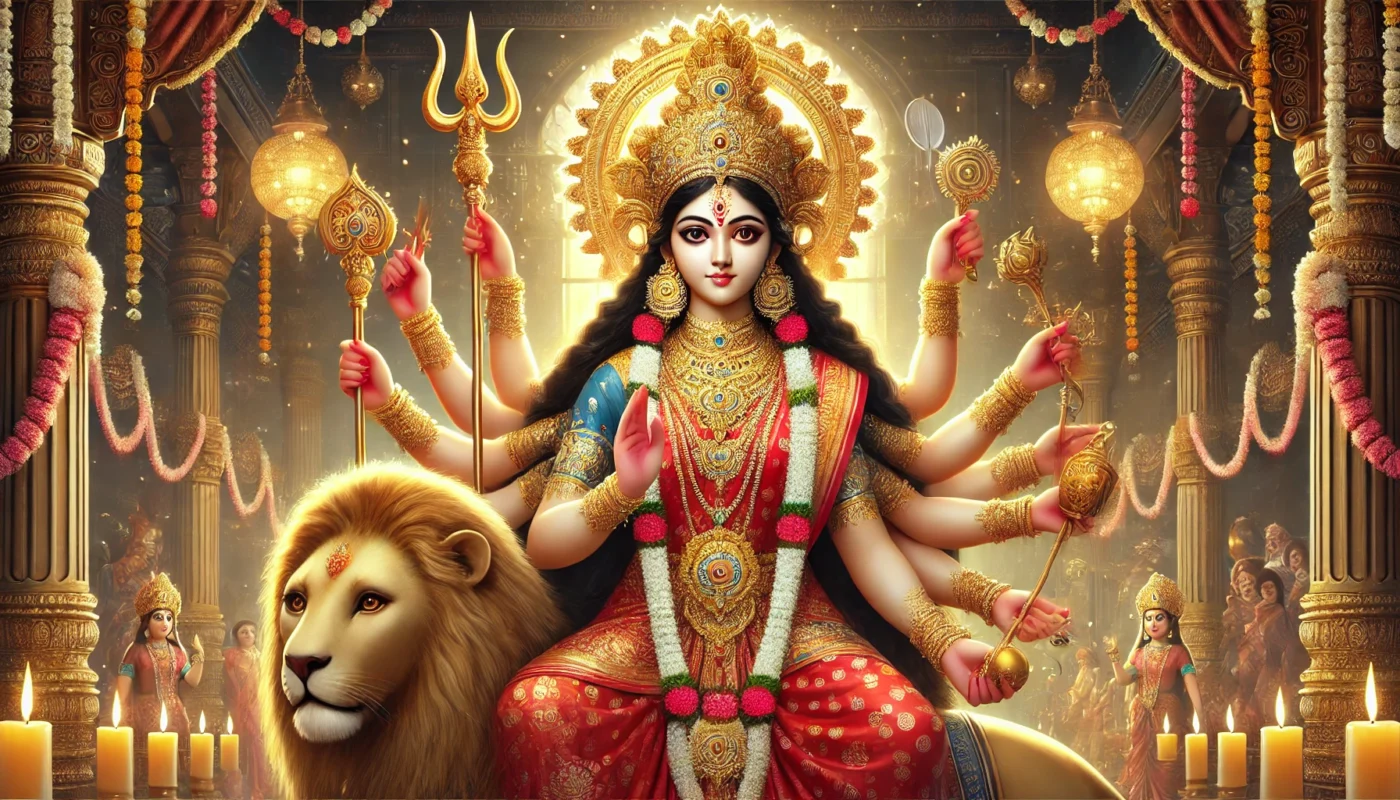Navratri is a festival dedicated to the worship of Goddess Durga, and during this auspicious time, Kalash Sthapana (Ghatasthapana) holds immense significance. The Kalash symbolizes purity, prosperity, and the divine energy of Goddess Durga. Performing the Kalash Sthapana with proper rituals is considered essential, as it is believed to invoke the presence of the Goddess in our homes. In this article, we will explore the step-by-step process of Kalash Sthapana and the rules and guidelines to follow during Navratri.
Table of Contents
Materials Required for Kalash Sthapana:

To perform Kalash Sthapana, you will need the following items:
- Earthen pot (for sowing barley seeds)
- Clean soil
- Barley seeds (known as ‘jow’ or ‘jawara’)
- Copper, brass, or clay pot (Kalash)
- Pure water
- Mango or Ashoka leaves
- Coconut (wrapped in a red cloth)
- Red cloth
- Flowers, rice (Akshat), vermillion, turmeric, betel nut, betel leaf
- Sacred thread (mouli), sandalwood paste, and incense sticks
Auspicious Time for Kalash Sthapana:
The timing of Kalash Sthapana is crucial and should be performed during a Shubh Muhurat (auspicious time). Performing the Kalash Sthapana during the early morning hours or Abhijit Muhurat is considered highly favorable. Checking the Hindu Panchang (calendar) for the exact timings ensures that the ritual is performed correctly and that the blessings of the Goddess are invoked.
Step-by-Step Process for Kalash Sthapana:

1. Select and Purify the Puja Area:
Begin by selecting the area where the Kalash will be installed. Clean the space thoroughly and purify it by sprinkling Ganga Jal (holy water). The Puja area should ideally be in the east or north direction of your home. Place a wooden plank (chowki) and cover it with a clean red or yellow cloth. Install a picture or idol of Goddess Durga at the Puja spot.
2. Prepare the Pot and Sow Barley Seeds:
Take an earthen pot and fill it with clean soil. Sow barley seeds (jow) in the soil, which symbolize prosperity and growth. Once the seeds are sown, place this pot near the Puja area where the Kalash will be established. Barley sprouts are believed to represent good fortune and are closely monitored throughout Navratri.
3. Perform the Kalash Sthapana:
Take the copper, brass, or clay Kalash and fill it with pure water. Add a betel nut, a few coins, and some rice grains (Akshat) to the water. Tie a sacred thread (mouli) around the neck of the Kalash. Place mango or Ashoka leaves around the mouth of the Kalash. Now, wrap a coconut in a red cloth and place it on top of the Kalash. The coconut should be positioned in such a way that the eye of the coconut faces outward, symbolizing divine presence.
4. Invoke Goddess Durga:
After the Kalash is installed, offer prayers to Goddess Durga by lighting a lamp, incense sticks, and offering flowers. Chant sacred hymns and mantras such as the Durga Saptashati or Durga Chalisa to invoke her divine presence. The Kalash now serves as a representation of the Goddess throughout Navratri.
5. Take Care of Barley Sprouts:
Over the nine days of Navratri, ensure that the barley (jow) seeds are watered daily. The growth of the barley signifies abundance and prosperity. It is said that the healthier the sprouts, the more prosperous the year ahead will be for the household.
6. Kalash Visarjan on Navami or Dashami:
At the end of Navratri, on Ashtami, Navami, or Dashami, the Kalash should be immersed in water during the Visarjan ritual. This is the symbolic conclusion of Navratri, where Goddess Durga is bid farewell, and her blessings are requested for peace, prosperity, and protection. It is also customary to offer new clothes, jewelry, or any offerings to the Goddess during the Visarjan ceremony.
Rules and Guidelines for Kalash Sthapana:
- The ritual should be performed with devotion and a pure heart.
- Maintain cleanliness and purity in the Puja area at all times.
- Observe a fast during the nine days and consume only satvik (pure) food.
- Offer daily prayers to Goddess Durga and recite holy scriptures like the Durga Saptashati.
- Wear clean, traditional clothes during the Puja, preferably in white or red, as these colors are considered auspicious.
- Encourage all family members to participate in the Puja and recite the Aarti together for collective blessings.
Kalash Sthapana is one of the most important rituals performed during Navratri. Following the proper guidelines and rules for this ritual brings peace, prosperity, and divine grace into the home. The nine days of Navratri are dedicated to honoring Goddess Durga, and the Kalash serves as a medium through which her blessings can be received. By nurturing the barley sprouts and performing daily prayers, devotees maintain a connection with the divine energy of Goddess Durga throughout the festival.







